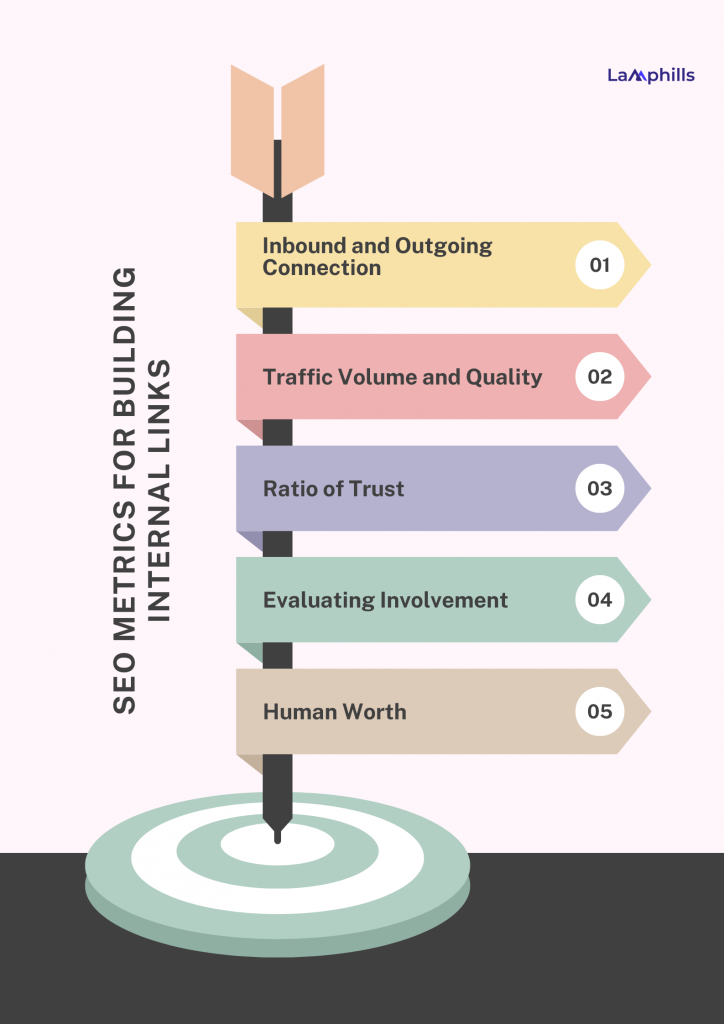With my years of experience as a content writer, I can boldly say that link-building metrics are still quite important in the constantly changing field of search engine optimization. This strategy is crucial to increasing your website’s search engine rating and visitors. However, you must monitor your progress to ensure you obtain the intended effects.
But, how do you assess the performance of your link-building initiatives?
A range of key performance indicators (KPIs) are available to assist you in assessing the success of your link-building initiatives. And in this article, we will cover 9 of the most important link-building metrics you should measure and track for your campaigns.
Key Takeaways
- High DA and PA scores indicate robust backlink profiles. To improve these metrics, focus on obtaining high-quality backlinks from reputable websites, as these scores are essential to raising your website’s ranking potential.
- TF gauges the quantity of backlinks, and CF gauges their quality and reliability. A robust backlink profile requires a balanced TF to CF ratio. To ensure a robust and reliable backlink profile, prioritize obtaining high-quality, authoritative links (high TF) and growing the number of backlinks (high CF).
- Use natural, diversified anchor texts appropriate for the information they connect to. This diversity enhances your backlink profile’s relevancy and SEO efficacy by preventing over-optimization and possible penalties.
- Make getting backlinks from reputable, relevant websites your top priority. Links from trustworthy and thematically relevant websites increase your backlink profile’s trustworthiness and SEO value, improving search.
- A diverse backlink profile from numerous domains shows wide-ranging authority and trust. Developing backlinks from various sources fortifies your link profile overall, increasing its resilience and efficacy in enhancing your website’s search engine performance.
What Is Link Building
Link metrics are defined by Moz as obtaining links to your website from other websites. These links, sometimes called backlinks, endorse your website’s authority and pertinence within a specific sector or specialty. The procedure includes various links that contribute to the overall architecture of your website, including internal, outbound, and inbound links.
A strong user experience, excellent on-page SEO, strong SEO technological underpinnings, and link building all drive organic traffic through search engines—a crucial component of search engine optimization (SEO).
What Are Link Building Metrics
The several measurements and standards used to evaluate the efficacy and quality of backlinks pointing to a website are known as link-building metrics. These are the standards by which a link-building campaign’s effectiveness is evaluated.
These metrics aid the link builder in assessing the quality of the backlinks and the impact of link building on the search engine ranking of their website.
Link Metrics to Understand When Creating Links
Consider them as a starting point for comprehending the link value of various backlinks. I recommend using them as a starting point for further investigation and other SEO indicators.
Take a look at the link-building metrics you MUST be aware of:
#1. Placement of the Page’s Links
The link’s location pointing to your website from the connecting domain is another indicator of link quality and trust that Google looks at. The rationale behind this is related to the concepts of relevancy and trust we previously discussed.
Where would you post a link if you were the blog owner and wanted to share it with your readers? If it were important to you, it would probably be in the forefront, either at the top of a webpage or in the text you write discussing it.
The concept behind link placement is to demonstrate the weight and confidence an individual places in a link they create to another website.
It would likely be placed lower on the page or in a more hidden location, the less authority or trust they have.
Google detects the location of a link pointing to your website on the linking domain. They will use it to determine the level of trustworthiness to assign to your domain. They can also monitor the average position of the links pointing to your website overall. You won’t benefit from links primarily hidden nearly as much in terms of SEO.
Because of this, it’s critical to remember the locations of links you obtain while attempting to obtain them from other websites.
#2. Authority on Page (PA)
Another link-building indicator developed by Moz, page authority (PA), predicts how highly a website page will rank on search engine results pages. The PA scale, which ranges from 1 to 100, indicates how strong a single page’s backlink profile is.
It’s important to remember that directly influencing page authority is challenging. This is so because PA comprises multiple measures, each affecting the final result. There isn’t a “good” or “bad” page authority score because this is a comparing tool.
Checklist on the Importance of Link Metrics.pdf
#3. Domain Authority
A website’s overall value or authority (at the domain level) in the online community is gauged by its domain strength. It is a collection of information about the website, including its age, popularity, content, and the number of websites that connect to it.
The most well-known tool for determining a website’s domain strength is Moz Link Research. This is partially because Moz’s staff was responsible for its creation and because they have a well-established track record with quality metrics.
It can be used, first, to monitor the effectiveness of your link-building efforts. As you build more backlinks to your website, you ought to notice an improvement in its domain strength. It indicates you aren’t doing something correctly if it doesn’t get better even as you receive more links.
Furthermore, you should use it to connect to targets on other websites with high domain authority scores. It’s unlikely that your domain strength will rise significantly if all of the links you receive are from low-authority websites. Links from reputable websites, such as well-known news organizations, academic institutions, and business titans, are what you want to obtain.
#4. Quantity of Links
The number of links is a very self-explanatory measure. It is simple to monitor and comprehend because it relates to the number of links pointing to your website. Even if the total number of connections is not a guarantee of success in and of itself, as we have already discussed, it is nevertheless a helpful indicator to track.
You can use it to determine whether you are losing active links. Prioritizing those websites is beneficial. They are probably more willing to do so if they have previously linked to you. This prevents your campaign from becoming stagnant.
Additionally, it’s a great method for comparing your site to rivals that appear higher in search engine results.
#5. Page Strength
Like domain strength, page strength operates at the level of a single page on your website. Because Google uses PageRank, it is this group’s most widely used statistic. They grade each page on a scale of 0 to 10, with 10 representing the greatest possible strength score.
The PageRank or strength of every page on your website should generally peak at the home page and then gradually decrease from there. Your newest and less well-known pages will probably have the lowest scores, while your oldest and most popular pages will probably have the next-highest scores.
Any internet page can have its page strength checked using various methods. A free tool like prchecker.info can be used to determine Google’s PageRank.
Page strength is a helpful statistic for evaluating the credibility of the website and the page link when organizing your campaign. Links from websites with high domain strength scores are preferable, as are links from pages with strong page authority.
#6. Link Cost Per Unit
The ROI of your link-building strategy is the last link-building measure you should be worried about. Getting many high-quality, helpful links is great, but what if doing so comes at a higher cost than the value they provide? This is the application of cost-per-link.
Assume you are compiling a list of websites your link-building campaign will target. High authority domains are the first thing you add, followed by geographically and topically relevant websites, and so on. After that, you start thoroughly investigating every website to see if you can obtain a link from them.
To begin with, you can try obtaining links to them for free by cold-contacting them, creating partnerships, checking for broken links, and other methods. Those are typically far harder to obtain. Then, you can find out if they accept sponsored posts or paid guest posts; however, you might find that the fee per post is too high for you.
For a set price or fee, you may also investigate hiring a professional link-building agency to create the links. You can split the service charge by the links they create to see whether the service is worthwhile. It will be helpful to determine whether or not you want to continue utilizing them based on that cost-per-lead.
#7. Connecting the Root Domains
Another crucial metric for gauging the effectiveness of your link-building effort is the linking of root domains. While having many connections is important, having links from a few websites reduces their value.
Gaining links from a greater number of distinct domains is preferable. This indicator has a far greater beneficial influence on your website than overall links. For instance, it’s usually preferable to have five links from five distinct domains rather than five from just one.
This is because of the way Google handles backlinks. Consider them a testimonial; when another website connects to yours, it’s interpreted as a digital affirmation that they respect and enjoy your content.
Therefore, it is assumed that if the same domain connects to your website more than once, it is the same individual reiterating their endorsement of it. This doesn’t inform Google anything new about how users generally view your website as trustworthy.
#8. Link text
The precise text with a hyperlink pointing to your website is known as anchor text.
It is crucial since it aids in indicating to search engines what a page is about. In terms of the SEO value of the material on your website, it accomplishes the same thing as keywords.
Assume that your company is a dental facility. When another website links to yours, including your main keywords in the anchor text is always preferable. For local link building, this includes terms like “dentist” and associated goods and services, in addition to the location where your company is situated.
Over the past few years, the strict value of anchor text has decreased. This is largely because of abuse and spam. Since then, Google has changed its algorithm to give it less weight and to penalize websites that utilize it improperly.
#9. Quality of Linking Page
The quality component of the link-building measure is now included. Although linking domains and many connections are beneficial, balancing this with high-quality, helpful links is preferable. That was said previously when discussing domain authority, but the linking page’s relevancy is also crucial.
In this context, a “relevant link” refers to how similar the website that links to yours is. A link from a gardening website, for instance, would be more relevant for a landscaping company than it would be from a blog about video games.
You should aim for highly relevant links for your website for two key reasons. First, real website visitors and potential buyers will more likely be drawn to relevant connections. Let’s revisit the example from earlier. Compared to a blog about video games, a person visiting a gardening website is likelier to be interested in landscaping services.
The link’s inherent SEO value is the second justification. Google gives significant weight to Relevance in all of its algorithms. As we previously said, they appear to be paying more attention to the linking domain’s relevancy than anchor text.
Though it hasn’t been confirmed, there is some indication that this is the direction algorithm upgrades will go. Thus, whenever you prioritize connections from two websites that are otherwise equal, always choose the one that is more pertinent to your company.
SEO Metrics for Building Internal Links

I’ve covered a few of the industry’s more common metrics, which you’ll undoubtedly use in reports and other process components.
There are other metrics, though, that might not be as clear. These measures might be more ephemeral or subjective and might not be ones you would use in your reporting.
However, they are crucial to your internal procedure so that you can measure the caliber of the links you create and increase the effectiveness of your link-building efforts.
Now, let’s get started.
#1. Inbound and Outgoing Link
Another method of site sanitization is to examine a website’s outbound and incoming link profiles and the ratio of each.
This is explained by the idea that websites with many outlines are typically of lesser quality than the quantity of backlinks they have. Examples include mass-selling link farms or private blog networks with few backlinks and no editorial review process.
Just be careful not to be too rigorous, as this will impact how many targets you end up with in your final lists. A 3:1 ratio, or two outgoing links for every inward link, is what I would advise.
#2. Traffic Volume and Quality
A site’s traffic volume is a crucial factor to consider. As a result, any connections from that site should be valuable and may even generate referral traffic. After all, increased traffic to a website typically indicates a robust site with a real audience.
You can quickly assess this by using tools such as Ahrefs and Semrush, which measure traffic from both paid and organic searches.
#3. Ratio of Trust
Two Majestic metrics are Trust Flow and Citation Flow. Even though they are merely third-party analytics, Majestic’s approach is much more methodical, and they seem to have upped the bar in terms of SEO metrics.
Citation Flow is essentially a measure of link equity, whereas Trust Flow gauges a website’s authority based on the quality of its backlink profile.
#4. Evaluating Involvement
Once you’ve located a website with an audience similar to yours, you should look for indications of interaction.
Using tools like Buzzsumo and Semrush to measure social media activity, you can determine how much traffic the website receives.
It’s also a positive indication of engagement if users appear to be leaving comments on the content.
These websites might also have poor Citation or Trust Flow metrics, although that is frequently the case with very recently established but well-liked up-and-coming blogs.
#5. Human Worth
Any link targets must also be carefully examined from a more subjective, human perspective. Does the website offer value and a positive user experience, and is the content high quality?
Thus, we want to look for things such as:
- Fervent and insightful writing
- A hint of humanity in the words
Some depth of understanding and professional judgment Nice layout Simple navigation
Constantly adding new material also aids in the quick prospecting stage, filtering out low-quality link farms.
What are link metrics?
Link Metrics are the aggregate term for the factors used to rank search results. They include measures of domain authority, relevancy, and trust and express the significance of any particular webpage.
How do we measure link-building performance?
Pay attention to the patterns in your organic traffic. An uptick in organic traffic indicates that your attempts to build links are having an effect. Analyze Your SEO Performance: Examine your desired keywords’ search engine rankings. Increased rankings are a sign of a well-built link.
How do you evaluate the quality of a link?
- Relevance of anchor text.
- Connecting the quality and relevancy of page content.
- Linking the relevance and quality of a domain.
- Internet Protocol address.
- Location of the link.
What is the link used to measure?
The link, commonly known as a Gunter’s, is a unit of length that was once common in several English-speaking nations. It is typically abbreviated as “l.”, “li.”, or “link.” According to the current definition of US customary units, the link is 66⁄100 of a US survey foot, or 7.92 inches, or almost 20.12 cm.
How do you track link building?
Conversions, Domain Authority, and Search Ranking.
- Lead generation and leads.
- Page Views.
- Awareness of a brand on a national scale
- Awareness of brand (locally)
- high-standing connections.
Conclusion
Comprehending these link-building indicators is essential to link-building success and to organizing and managing your campaign effectively. By tracking your strategy, these SEO KPIs can help you maintain a strong return on investment and increase organic traffic.
- Link Building Outreach: Beginners Guide (+Templates)
- 15 Best Link Building Tools: A Comprehensive Review from My Personal Experience
- PR Evaluation Reports: Key Metrics and Best Practices
- Mastering the Art of PR ROI Measurement: Unlocking Metrics
- Backlink Outreach: Meaning, Types & How to Build a Successful One





